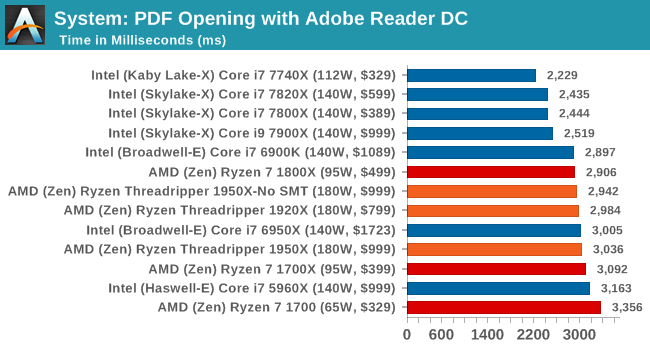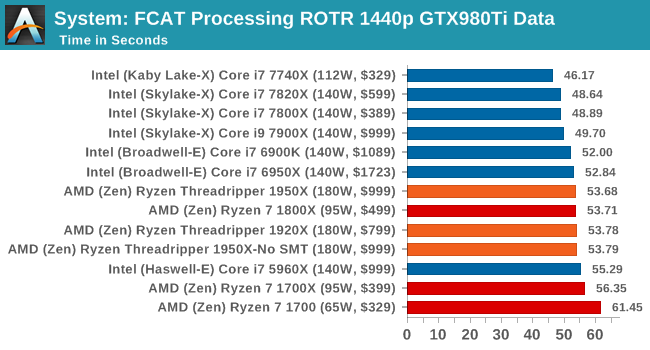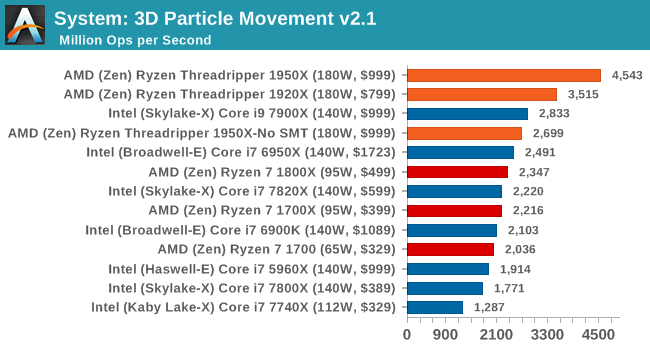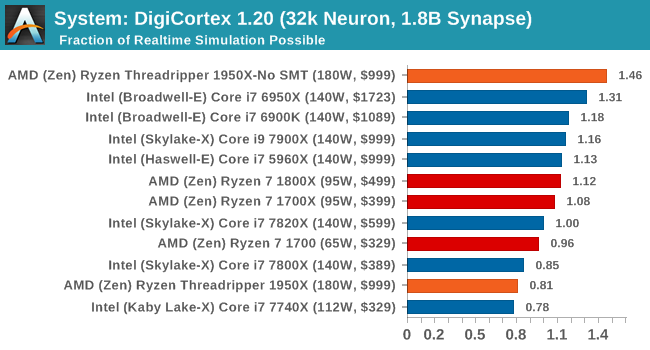The AMD Ryzen Threadripper 1950X and 1920X Review: CPUs on Steroids
by Ian Cutress on August 10, 2017 9:00 AM ESTCPU System Tests
Our first set of tests is our general system tests. These set of tests are meant to emulate more about what people usually do on a system, like opening large files or processing small stacks of data. This is a bit different to our office testing, which uses more industry standard benchmarks, and a few of the benchmarks here are relatively new and different.
All of our benchmark results can also be found in our benchmark engine, Bench.
PDF Opening
First up is a self-penned test using a monstrous PDF we once received in advance of attending an event. While the PDF was only a single page, it had so many high-quality layers embedded it was taking north of 15 seconds to open and to gain control on the mid-range notebook I was using at the time. This put it as a great candidate for our 'let's open an obnoxious PDF' test. Here we use Adobe Reader DC, and disable all the update functionality within. The benchmark sets the screen to 1080p, opens the PDF to in fit-to-screen mode, and measures the time from sending the command to open the PDF until it is fully displayed and the user can take control of the software again. The test is repeated ten times, and the average time taken. Results are in milliseconds.

This opening test is single threaded, so the high-frequency Intel parts get a clear win. There's not much between the Threadripper CPUs here.
FCAT Processing: link
One of the more interesting workloads that has crossed our desks in recent quarters is FCAT - the tool we use to measure and visually analyze stuttering in gaming due to dropped or runt frames. The FCAT process requires enabling a color-based overlay onto a game, recording the gameplay, and then parsing the video file through the analysis software. The software is mostly single-threaded, however because the video is basically in a raw format, the file size is large and requires moving a lot of data around. For our test, we take a 90-second clip of the Rise of the Tomb Raider benchmark running on a GTX 980 Ti at 1440p, which comes in around 21 GB, and measure the time it takes to process through the visual analysis tool.

Similar to PDF opening, single threaded performance wins out.
Dolphin Benchmark: link
Many emulators are often bound by single thread CPU performance, and general reports tended to suggest that Haswell provided a significant boost to emulator performance. This benchmark runs a Wii program that ray traces a complex 3D scene inside the Dolphin Wii emulator. Performance on this benchmark is a good proxy of the speed of Dolphin CPU emulation, which is an intensive single core task using most aspects of a CPU. Results are given in minutes, where the Wii itself scores 17.53 minutes.

Dolphin likes single thread performance as well, although having some cores to back it up seems to be required.
3D Movement Algorithm Test v2.1: link
This is the latest version of the self-penned 3DPM benchmark. The goal of 3DPM is to simulate semi-optimized scientific algorithms taken directly from my doctorate thesis. Version 2.1 improves over 2.0 by passing the main particle structs by reference rather than by value, and decreasing the amount of double->float->double recasts the compiler was adding in. It affords a ~25% speed-up over v2.0, which means new data.

Our first pure multithreaded test, and the 1950X wins with 32 threads. The 1920X beats the 1950X in SMT-off mode, due to 24 threads beating 16 threads.
DigiCortex v1.20: link
Despite being a couple of years old, the DigiCortex software is a pet project for the visualization of neuron and synapse activity in the brain. The software comes with a variety of benchmark modes, and we take the small benchmark which runs a 32k neuron/1.8B synapse simulation. The results on the output are given as a fraction of whether the system can simulate in real-time, so anything above a value of one is suitable for real-time work. The benchmark offers a 'no firing synapse' mode, which in essence detects DRAM and bus speed, however we take the firing mode which adds CPU work with every firing.

DigiCortex requires a mash of CPU frequency and DRAM performance to get a good result, and anything with quad-channel memory is usually preferred. The 1950X in SMT-off mode wins here due to its low main memory latency combined with having 16 threads to access it. The Broadwell-E is the nearest competitor, over Skylake-X, most likely due to the mesh vs ring topology. The 1950X in Creator mode scores way down the field however, lower than the standard Ryzen chips, showing that under a unified memory architecture there can be significant performance drops. The 1920X failed in this test for an unknown reason.
Agisoft Photoscan 1.0: link
Photoscan stays in our benchmark suite from the previous version, however now we are running on Windows 10 so features such as Speed Shift on the latest processors come into play. The concept of Photoscan is translating many 2D images into a 3D model - so the more detailed the images, and the more you have, the better the model. The algorithm has four stages, some single threaded and some multi-threaded, along with some cache/memory dependency in there as well. For some of the more variable threaded workload, features such as Speed Shift and XFR will be able to take advantage of CPU stalls or downtime, giving sizeable speedups on newer microarchitectures.

The variable threaded nature of Agisoft shows that in our workflow, it's a mix of cores, IPC and frequency required to win. AMD takes a back seat here, likely due to its AVX implementation.










347 Comments
View All Comments
Lolimaster - Friday, August 11, 2017 - link
A single 1950X destroyed 80% of the intel xeon lineup.Lolimaster - Friday, August 11, 2017 - link
Any cpu after nehalem perform enough at single thread except for software optimized too much for certain brands, like dolphin and intel.Lolimaster - Friday, August 11, 2017 - link
Specially when every cpu right now autoclocks to 4Ghz on ST tasks. Single thread is just an obsolete metric when just the most basic of tasks will use it, tasks the last thing you will worry is speed, maybe curse about that piece of c*rap not using 80% of you cpu resources.ZeroPointEF - Thursday, August 10, 2017 - link
I would love to see more VM benchmarking on these types of CPUs. I would also love to see how a desktop performs on top of a Server 2016 hypervisor with multiple servers (Windows and Linux) running on top of the same hypervisor.ZeroPointEF - Thursday, August 10, 2017 - link
I should have made it clear that I loved the review. Ian's reviews are always great!I would just like to see these types of things in addition. It seems like we are getting to a point where we can have our own home lab and a desktop all on one machine on top of a hypervisor, but this idea may be my own strange dream.
smilingcrow - Thursday, August 10, 2017 - link
And others would like to know how it works at video editing or as a DAW etc.To add a whole bunch of demanding benchmarks just for HEDT systems is a hell of a lot of work for little return for a site whose main focus is the mainstream.
Try looking at more specialised reviews.
johnnycanadian - Thursday, August 10, 2017 - link
This, please! My TR purchase is hinging on the performance of multiple VMWare VMs all running full-out at least 18 hours per day.Ian, I'd love to see some of your compute-intensive multi-core benches running on a Linux host with Linux-based VMWare VMs (OpenCV analysis, anyone? Send me that 1950x and I'll happily run SIFT and SURF analysis all day long for you :-). I was delighted by the non-gaming benchmarks shown first in this review and hope to see more professional benches on Anand. Leave the gamerkids to Tom's or HardOCP (or at least limit gaming benchmarks to hardware that is built for it): Anandtech has always been more about folks who make their living on HPDC, and I have nothing but the highest respect for the technical staff at this publication.
I don't give a monkey's about RGB lighting, tempered glass cases, 4k gaming or GTAV FPS. How machines like Threadripper perform in a HPC environment is going to keep AMD in this market, and I sincerely hope they prove to be viable.
mapesdhs - Thursday, August 10, 2017 - link
Yes, I was pleased to see the non-gaming tests presented first, makes a change, and at least a subtle nod to the larger intended market for TR.Ian.
pm9819 - Friday, August 18, 2017 - link
Your going to spend a $1000 on cpu but have no clue how it handles the tasks you need it for, smh. As a VMWare customer they will tell you which cpu has been certified to handle a specific tasked. You don't need a random website to tell you that.nitin213 - Thursday, August 10, 2017 - link
Hi IanIt's a great review but i do have some suggestions on the test suite. The test suite for this CPU was not materially different from test suites of many of the other desktop CPUs done earlier. I think it would be great to see some tests which explicitly put to use the multi-threaded capabilities and the insane IOs of the system to test, e.g server hosting with how many users being able to login, virtual machines, more productivity test suites when put together with a multi-GPU setup (running adobe creator or similar) etc. I think a combination of your epyc test suite and your high-end GPU test suite would probably be best suited for this.
Also, for the gaming benchmark, it seemed you had 1080, 1060, rx580 and rx480 GPUs. Not sure if these were being bottlenecked by GPU with differences in framerates being semantic and not necessarily a show of PC strength. Also, Civ 6 AI test suite would a great addition as that really stresses the CPU.
i completely understand that there is only so much that can be done in a limited timeframe typically made available for these reviews but would be great to see these tests in future iterations and updates.